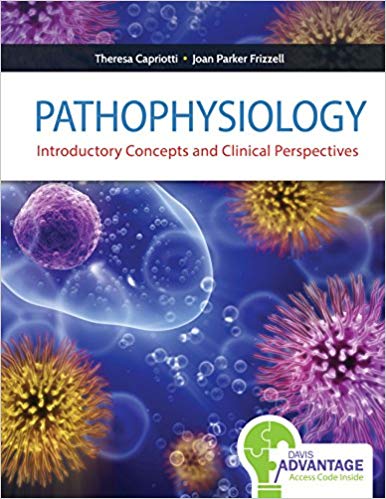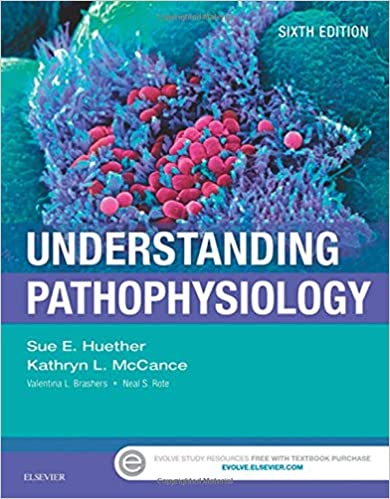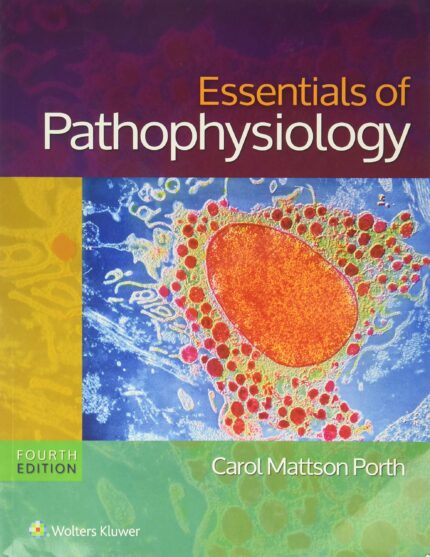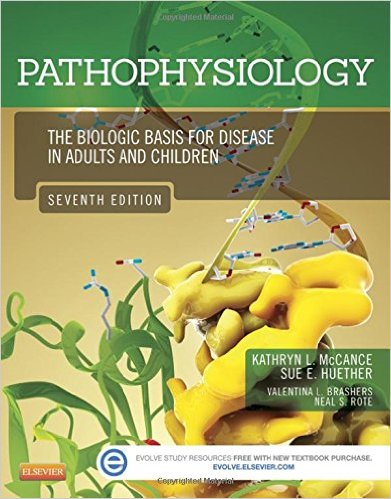Pathophysiology 5th Edition by Lee-Ellen C. Copstead – Test Bank
Chapter 5: Genome Structure, Regulation, and Tissue Differentiation Test Bank
MULTIPLE CHOICE
1. Approximately what percentage of the human DNA chromosomes code for proteins? a. 1%
b. 10% c. 50% d. 80%
ANS: A
Only about 1.3% of chromosomal DNA codes for proteins.
REF: Pg. 75
2. Which tissue type is categorized as epithelial?
- Tendons and ligaments
- Blood cells
- Blood vessel endothelium
- Cartilage
ANS: C
Epithelial cells line glands, blood vessels, and internal surfaces. Tendons, ligaments, blood cells, and cartilage are connective tissue.
REF: Pg. 84
3. An important difference between skeletal and cardiac muscle is that
- cardiac muscle is not striated.
- only skeletal muscle is dependent upon actin-myosin cross-bridging.
- calcium does not leave the sarcoplasmic reticulum in cardiac cells.
- cardiac muscle has calcium channels on the cell surface for calcium entry.
ANS: D
Only cardiac muscle has calcium channels on the cell surface for calcium entry into the cell. Drugs called calcium channel blockers are used to decrease calcium entry into cardiac cells to reduce contractile force in treating hypertension. CCBs also relax smooth muscle in arterial blood vessels to treat hypertension. Both cardiac and skeletal muscle are striated, and both cardiac depend upon actin-myosin cross-bridging for contraction. Calcium leaves the sarcoplasmic reticulum in both cardiac and skeletal muscle.
REF: Pg. 88
4. The primary role of genes is to
- code for reproduction.
- direct the synthesis of proteins.
- determine differentiation.
- determine cellular apoptosis.
ANS: B
Protein synthesis holds a predominant place in understanding how genes direct cell structure and function. Although genes are involved in reproduction, differentiation, and apoptosis indirectly, the primary role of genes in the body is protein synthesis.
REF: Pg. 77
5. The differences in structure and function of cells in different body tissues is due to
- gene differences in tissue cells.
- expression of tissue-specific genes.
- transcriptional controls.
- translation of amino acids to proteins.
ANS: B
The expression of genes results in differences among cells, and thus tissue types. All cells in the body contain basically the same genes. Expression of genes is influenced by memory of cells regarding events prior to cell division, not differences ingene structure. As genes in all body cells/tissues is basically the same; transcription and translation do not influence cell/tissue differences.
REF: Pg. 81
6. Characteristics of smooth muscle include
- being under voluntary control.
- having striations.
- contraction being short-lived.
- being found in blood vessels.
ANS: D
Smooth muscle is found in blood vessels. It is not under voluntary control and is often controlled by the autonomic nervous system. Skeletal and cardiac muscle have striations. Contraction can occur indefinitely; it is not short-lived, which is important in maintaining tone of blood vessels and, thus, blood pressure.
REF: Pg. 88
Copyright © 2013, 2010, 2005 Saunders, an imprint of Elsevier Inc. All rights reserved. 1
MULTIPLE RESPONSE
7. Characteristics of cellular differentiation include which of the following? (Select all that apply.)
- Specialization for different functions
- Enhanced ability to replicate
- Influenced by memory of developmental events
- Dependent on cell-to-cell coordination
- Generally not reversible
ANS: A, C, D, E
The cells of a multicellular organism specialize to perform particular functions in coordination with other cells in the body. Cells have genetic memory; they retain the effects of past influences and pass the memory on to their descendants. Continued interaction with nearby cells provides clues to guide the cell to its appropriate form and location. Once differentiated, a cell generally does not revert to earlier forms. Differentiation results in decreased capacity to replicate.
REF: Pgs. 83-84
8. In DNA replication DNA polymerase functions to (Select all that apply.)
- pry DNA apart.
- unwind and separate the DNA strands.
- prevent tangling of DNA strands as they unwind.
- match appropriate bases to the template base.
- proofread the newly developed DNA for errors in base pairing.
ANS: D, E
DNA polymerase functions to match appropriate bases to the new template base following unwinding of the DNA strands and proofreads for errors after base pairing is completed. Initiator proteins pry the DNA strands apart. DNA helicases unwind the DNA strands. Topoisomerases keep the strands from becoming tangled.
REF: Pg. 77
9. Protein synthesis involves (Select all that apply.)
- direction from mRNA.
- amino acid movement into the nucleus.
- nucleotide triplets.
- RNA polymerase.
- removal of introns from the DNA template.
ANS: A, C, D, E
Messenger RNA (mRNA) is needed to carry the protein code to the cytoplasm where proteins are synthesized. Three nucleotides are need to code for each amino acid, the building blocks of protein. RNA polymerase directs the separation of the DNA strands and catalyzes the synthesis of mRNA from the DNA template after separation of the strands. Introns are removed from the DNA template to make particular proteins. Amino acids are moved from the nucleus to the cytoplasm, where protein synthesis occurs.
REF: Pgs. 77-80
10. Characteristics of stem cells include that they (Select all that apply.)
- may differentiate into any type of cell.
- reside only in the bone marrow.
- have greater capacity to proliferate than more differentiated cells.
- are dependent upon environmental cues for proliferation.
- can die in the absence of an appropriate environment.
ANS: A, C, D, E
Stem cells are pluripotent—they can differentiate into any type of cell. They can proliferate faster and longer than more differentiated cells if the environment is appropriate and can die if the environment in not appropriate. While most blood-forming stem cells reside in the bone marrow, others can move into tissues and produce cells as needed; for example, epithelial stem cells reside in the deepest layer of the epidermis and proliferate into epithelial cells when needed.
REF: Pg. 84
11. Calcium channel blocker drugs are often used to treat conditions associated with (Select all that apply.)
- cardiac muscle.
- smooth muscle.
- epithelial tissue.
- nervous tissue.
- connective tissue.
ANS: A,B
Calcium channel blockers are often used to treat cardiac conditions in an effort to reduce the strength of contraction by stopping calcium influx into the cells. They are also used in smooth muscle of the blood vessels to relax the smooth muscle in the arterial blood vessels to cause vasodilation and reduce blood pressure. They are not useful for conditions involving epithelial, nervous, or connective tissue.
REF: Pg. 89













Reviews
There are no reviews yet.